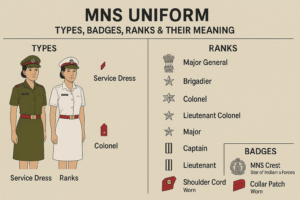1. Background of the Deal
The United States has confirmed the supply of AIM-120 AMRAAM missiles to Pakistan.
The announcement follows Pakistan Prime Minister Shehbaz Sharif’s visit to Washington.
The deal is part of a new phase in defence cooperation between the two countries.
It involves an expanded contract with Raytheon, the US-based defence manufacturer.
Contract Value: Over $2.51 billion.
Completion Timeline: Expected by May 2030.
Variants Included: AIM-120 C8 and D3 (latest and most advanced versions).
2. What Is the AIM-120 AMRAAM Missile?
Full Form: Advanced Medium-Range Air-to-Air Missile (AMRAAM).
Type: Beyond Visual Range (BVR) air-to-air missile.
Developed by: United States (Raytheon).
Operational Since: 1991 (development started in the late 1970s–1980s).
Speed: Nearly Mach 4 (~4 times the speed of sound).
Guidance System:
Fire-and-forget technology – after launch, no need for pilot guidance.
Active radar homing – missile carries its own radar to track targets.
Capabilities:
Engages targets at long ranges (up to 160 km under ideal conditions).
Operates effectively in all weather conditions.
High accuracy, range, and resistance to jamming (especially in C8 and D3 variants).
3. Key Features of the Latest Versions (C8 and D3)
Extended range and improved propulsion system.
Enhanced electronic counter-countermeasures (ECCM) to overcome jamming.
Compact design, allowing more missiles to be carried on aircraft.
Better integration with modern fighter aircraft radars and avionics.
4. Global Users of AMRAAM
Used by 40+ countries globally.
Major Operators: USA, UK, Japan, Germany, Australia, Norway, and now Pakistan.
Compatible Aircraft:
US: F-15, F-16, F/A-18, F-22, F-35
Europe: Eurofighter Typhoon, Saab Gripen
Pakistan: F-16 Fighting Falcon
5. Limitations of AMRAAM
Range variability: Actual combat range may be lower than 160 km due to:
Altitude of launch
Target manoeuvrability
Electronic warfare and countermeasures
High cost: Expensive to produce and maintain; reserved for critical missions, not routine patrols.
Dependency on radar data: Effectiveness depends on radar lock and data-link quality.
6. India’s Equivalent: The Astra Missile
Developed by: DRDO (Defence Research and Development Organisation), India.
Type: Beyond Visual Range (BVR) air-to-air missile.
Range: 80–110 km.
Speed: Over Mach 4.
Guidance System:
Inertial navigation system + active radar homing.
Compatible Aircraft: Su-30MKI, Tejas, and future integration with Mirage-2000 and MiG-29.
Significance:
Boosts indigenous defence capability.
Reduces dependence on foreign arms.
Aligns with Atmanirbhar Bharat in defence production.
7. Strategic Significance of the Deal
For Pakistan
Strengthens air combat and interception capabilities.
Enhances deterrence against regional adversaries (especially India).
Reflects efforts to diversify defence partnerships, not rely solely on China.
Supports maintenance and upgrade of its F-16 fleet.
For the United States
Revives defence ties with Pakistan after a long lull post-2011 (Osama bin Laden episode).
Helps maintain leverage over Pakistan’s military establishment.
Part of regional balancing strategy — managing ties with both India and Pakistan.
Strengthens counterterrorism and strategic influence in South Asia amid China’s growing role.
For India
Raises concerns over regional security balance.
India views US arms supply to Pakistan as strategically sensitive, despite the Indo-US partnership.
However, India’s focus on indigenous missile programs (like Astra and SFDR-based Astra Mk2) provides a counterbalance.
8. Broader Geopolitical Context
Comes amid growing US-China competition in South Asia.
Pakistan seeks to reduce dependency on China’s defence sector (esp. under CPEC framework).
The US uses such deals to retain influence in Islamabad, even while deepening ties with New Delhi through platforms like:
Quad (with India, Japan, Australia, US)
iCET (Initiative on Critical and Emerging Technologies).
9. Prelims Pointers
| Feature | AIM-120 AMRAAM | Astra Missile |
|---|---|---|
| Origin | United States | India (DRDO) |
| Type | BVR Air-to-Air | BVR Air-to-Air |
| Speed | ~Mach 4 | ~Mach 4+ |
| Range | Up to 160 km | 80–110 km |
| Guidance | Active radar homing | Inertial + Active radar |
| Compatible Aircraft | F-15, F-16, F-35, Typhoon | Su-30MKI, Tejas |
| Status | Operational in 40+ countries | Indigenous, inducted in IAF |
10. UPSC Mains Relevance
GS Paper 2 – International Relations
Topic: India and its neighbourhood relations
Keywords: US-Pakistan Defence Cooperation, Strategic Balance, Arms Diplomacy, South Asia Security.
Possible Question:
“Discuss the strategic implications of renewed US-Pakistan defence cooperation for India’s security and regional stability in South Asia.”
GS Paper 3 – Internal Security / Defence
Role of indigenous defence production in maintaining strategic autonomy (Astra missile case study).
11. Summary for Quick Revision
US–Pakistan deal: $2.51 billion for AIM-120 C8/D3 missiles.
Enhances Pakistan’s air combat capability.
US aims to maintain influence in Pakistan amid China’s rise.
India counters with indigenous Astra missile development.
Implication: Renewed great-power competition shaping South Asian defence dynamics.
📘 Source for UPSC Study: www.victorgrowth.com







